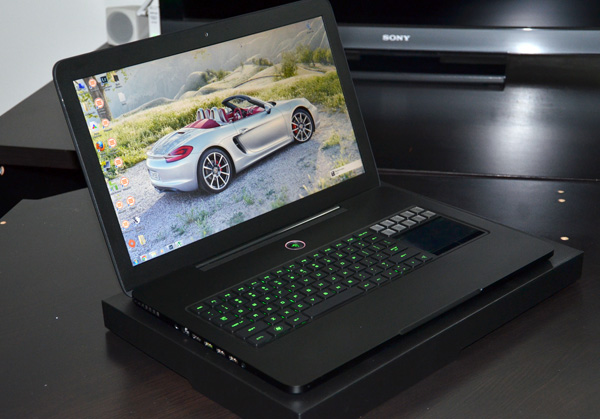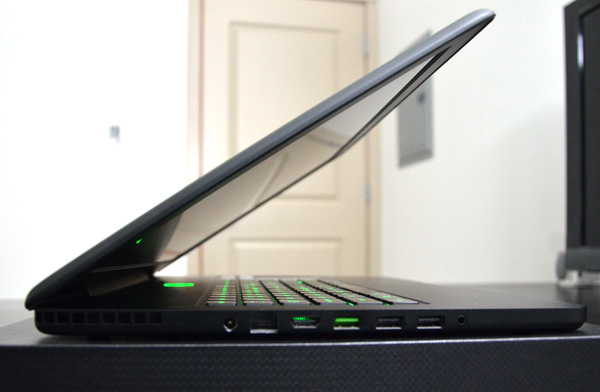The Razer Blade Review
by Vivek Gowri & Jarred Walton on March 15, 2012 3:01 AM ESTThere is something absolutely arresting about the Blade’s overall aesthetic. It’s big, but so strikingly thin at the same time, and the matte black paintjob is like a visual black hole. The overall effect is eye-catching, breathtaking, and will cause random passerby to stop and ask questions.
The design language is really, really clean and rather understated, two things you don’t expect from most gaming notebooks, while still keeping a sense of flair about it. The lid has two ribs vertically arranged on either side of the glowing Razer logo on the back, breaking up the monotony of the otherwise flat profile of the lid. Everything here is very uniformly laid out—lots of rectangles with radiused edges, no extraneous design elements, but unlike Apple’s portables, there’s no feeling of overwhelming sterility. Apple has taken the minimalist design philosophy so far that the MacBook Pro design language feels almost soulless.
The Blade doesn’t have that problem. The flat black aesthetic is offset by green accents—lots of them. The Razer logo on the back lights up in green, the power button has a Razer logo that glows green and pulsates almost like a heartbeat, the USB 3.0 port is green, the keys on the keyboard are green, a lot of the UI elements of the Switchlade panel are green, the list goes on. The industrial design is very clean, but what’s impressive is the overall polish in the design and how the whole thing ties together. It’s the little things—the attention to detail borders on obsessive, and that’s very good to see.
No matter what you think about the specs or the price, it’s impossible to ignore the fact that the Blade is a gorgeous, gorgeous device. It’s very obviously built to a high standard of build quality, with a machined aluminum unibody chassis that, even being so thin, is very structurally rigid. The lid and hinge are also pretty sturdy feeling, and the keyboard has no flex. Nothing about the look and feel of the Blade suggests anything less than a truly premium product.
In terms of ports, the Blade is pretty sparse. There’s one USB 3.0, two USB 2.0, HDMI, gigabit Ethernet, combo headphone jack/line in, and AC power all on the left side of the machine, as well as a Kensington lock on the right side. I’d definitely have liked to see an SD card slot here, along with one more USB 3.0 port, but given the form factor, you can understand why the Blade doesn’t have too much in the way of ports. The reason almost all the ports are on the left side is so that when at a desk using a mouse, gamers won’t ever run into the peripheral devices connected. Close to the back of the unit, there’s vents on either side; GPU on the right, CPU on the left.
The front is also completely clean, other than the angled cutout for opening the latch-less screen. The back of the system is dominated by the hinge, a right-angled piece that borrows from Apple’s playbook for designing low-profile hinges. The bottom of the system is also pretty minimalist, with chrome-ringed heat vents on the right and left sides, FCC information silk screened onto the body, and the Windows COA sticker. The heat vents are nice in that they are angled such that they blow air towards the rear of the notebook, away from the user.
The LCD bezel is thicker than I’d like, but the larger footprint was probably necessitated by the super-thin form factor. Above the display, we find the 2.0MP webcam, mic, and light sensor, while below it we find the highly stylised Blade logo rendered in glossy black. Against the metallic matte black of the rest of the interior, it’s understated yet incredibly cool looking.
The rest of the interior is pretty interesting. First things first, there’s no touchpad in the conventional sense—what happened, effectively, is that the touch-based input device got moved to where the keyboard’s number pad would be, leaving the area underneath the keyboard completely free. The keyboard and Switchblade are important enough to deserve their own page, but the rearranging of the touchpad enabled Razer to do some interesting things with the design. There’s much more space above the keyboard than you’d typically find on a notebook, something that Razer took advantage of by piping most of the heat generated by the CPU and GPU to that area. It’s not somewhere where people typically touch their computers, unlike the bottom or the palmrests, so engineering the thermal system to move heat towards the rear left corner was a good idea. Razer put vents on both sides of the Blade, but a majority of the heat is exhausted from the one on the left because the design team didn’t want hot air blowing on the mouse hand (when using an external mouse). It’s touches like this that impress—it’s rare to find this kind of polish or attention to detail in a company’s first computer.





















95 Comments
View All Comments
Swirlser - Thursday, March 15, 2012 - link
Looks pretty, but really any "gamer" that drops several grand on a laptop on the eve of both a gpu and cpu shrink has far more money than sense.Didnt read full article - but if its available now, order it *immediately*, coz if you wait a few weeks its going to be officially past its sell by date on its very first boot up ;-p (not a great start for the "World's first true gaming laptop" o.O)
DelicateThunder - Thursday, March 15, 2012 - link
On the first page, "6.4 lbs 1.36kg". Seems more like 2.9kg for me.Death666Angel - Thursday, March 15, 2012 - link
A lot of gimmicks that are not necessarily wanted by gamers, mediocre hardware for the money and for gaming, a price tag that has to compete with more powerful offers and a thinness that I don't think gamers really need.... So who is this thing for?Xuvial - Thursday, March 15, 2012 - link
So basically this is aimed at people who are willing to shell out stupid amounts of money just so they can get their hands on something that LOOKS different.Got it.
bryanlarsen - Thursday, March 15, 2012 - link
Lots of haters here in the comments, but I think it's a fabulous design.What I'm looking for:
- good portability
- great screen
- excellent CPU performance for work
- nice design that's not exactly the same as every other laptop in the coffee shop
- enough performance to adequately play the occasional game of Skyrim or Civ5.
That trackpad design is absolutely brilliant. Trackpad on the right makes so much more sense than below the keyboard. Topped with a bunch of macro keys in a very convenient location (when your right hand is using the trackpad: most of the time, in other words).
What's turning me off:
- crappy keyboard for work
- irritating fan noise
- lack of Linux support (assumption, but probably a safe one)
looking forward to the ivy bridge / kepler refresh
aferox - Thursday, March 15, 2012 - link
I do like some of the things Razer has done with this, especially the weight. However, the Razer Blade was obviously designed by right-handed individuals for right-handed individuals. As a leftie, I would consider this design impossible to use. My mouse would be on the left, where all of those ports and that hot air come out. That touchpad on the right? Exactly where I don't want it. Most designs do not really cater to left handers, but they can be used without too much fuss. Not this.snide23 - Thursday, March 15, 2012 - link
I'm with you. I know quite of few of us leftie gamers who wouldn't consider this setup. But apparently we are a minority.KaRRiLLioN - Wednesday, March 21, 2012 - link
I'm a leftie, but I've always moused with my right hand.pyrthas - Thursday, March 15, 2012 - link
I understand the complaint, but for gaming, I'd much rather have it on the right, so that I have the extra key under my left hand.piroroadkill - Thursday, March 15, 2012 - link
Yes, exactly. I think the Fn placement is no cause for concern at all.